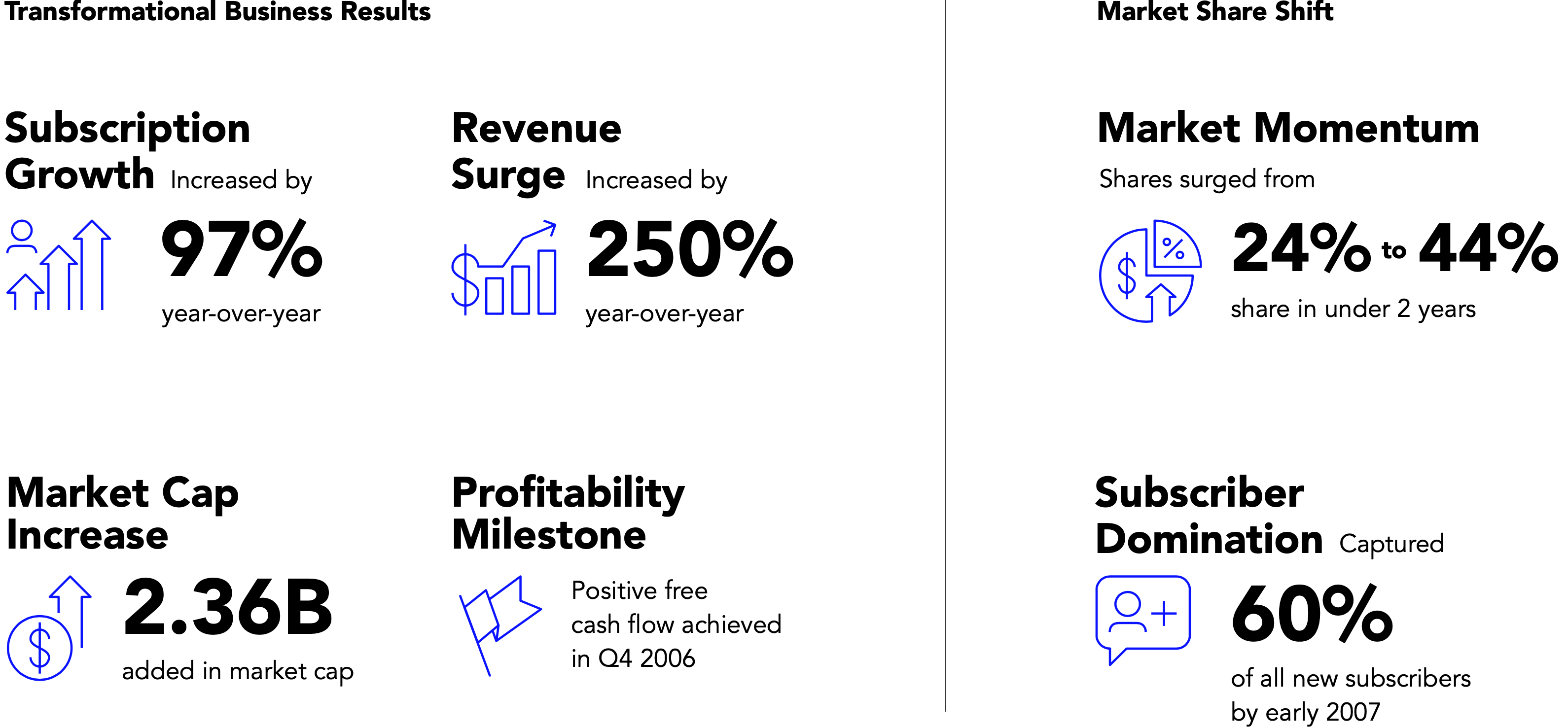How Ziba helped Sirius redefine a category
In 2005, Sirius Satellite Radio faced a crossroads. Despite billions invested in content, satellites, and high-profile talent like Howard Stern, the company was losing money and trailing far behind its rival, XM Radio. XM had nearly 4 million subscribers, while Sirius had only 1.5 million.
The strategy of bundling receivers with a free trial wasn’t translating into loyal customers. Worse, the media landscape was shifting rapidly. MP3 players, iPods, and early streaming services were offering people something traditional radio couldn’t: control, convenience, and instant gratification.
Sirius needed more than product improvements. It needed a breakthrough—a reason to matter in a world where radio was rapidly becoming irrelevant. To survive, Sirius had to do more than improve radio; it had to reimagine the entire experience.

That’s when Sirius turned to Ziba for a bold reinvention.
Using our proprietary Visioneering™ framework, we set out to answer a critical question: What makes radio worth listening to in a world of skip buttons, playlists, and endless algorithmic choice?
This wasn’t about refining the past. It was about defining what is next. The goal was clear: to ignite desire, enhance engagement, foster loyalty, and convert trial users into lifelong subscribers—quickly.
1. Data to Information

Searching for the Soul of Radio
To reimagine the radio experience, we began by rediscovering its essence. What draws people to satellite radio in the first place? When do they turn it on—and why do they tune out? What role does it play in their daily lives? Is it background noise, a trusted companion, or something else entirely?
We dug deep into the listener journey to understand how people discover satellite radio, what keeps them coming back, and what causes them to drift away. Because to design a breakthrough, we first had to find what makes it matter

Finding the Friction. Fueling the Future.
Ziba’s multidisciplinary team of researchers and designers launched an immersive, coast-to-coast investigation into how people engage with audio in their daily lives—at home, at work, and particularly in the car, where Sirius had its strongest presence.
We looked beyond demographics to uncover the emotional and behavioral patterns shaping how people connect with media and what it would take to make satellite radio matter to them. Our mission: to map the entire ecosystem through the lens of the listener.
2. Information to Knowledge

Mapping Minds. Shaping Experiences.
Through a series of perceptual and behavioral models, we transformed raw information and data into actionable knowledge. These strategic tools guided how Sirius could connect with users across moments, mindsets, and environments.
Engagement Models
Using systems thinking, we mapped how users engaged with media, balancing their desire for control with their craving for immersion. We plotted effort against value and discovered a key truth: the more intuitive and curated the experience, the more likely it was to earn attention and loyalty.
Behavioral Frameworks
We examined how people interact with audio media on emotional, functional, and situational levels.
We developed behavioral frameworks around:

Media Relationships
Not just what people listened to, but how and why it mattered in their lives

Travel Modes
How behaviors change during long commutes, quick errands, or road trips.

Media Fields
The personal goals that media supports, such as entertainment, discovery, focus, or escape.

Listening Environments
How Sirius could achieve seamless integration across the car, home, office, and mobile—creating a sense of continuity wherever users travel.

Strategic Target & Profiles
Our research also identified a new core audience for Sirius—our Strategic Target: the Cultural Creatives. These are time-starved individuals seeking meaning and inspiration, eager to improve their lives and shape the world around them, but only if it does not require extra effort. They represent a critical bridge: Fast Followers and Early Majority users who could help Sirius scale beyond early adopters and into mass relevance.
To bring this strategy to life, we defined five vivid user profiles—each grounded in a detailed archetype: The Business Charismatic, The Fan, The Family Chauffeur, The Traveling Salesman, and The Tuner. Each profile includes a summary of key needs and a 360° behavioral journey—capturing what attracts them, what keeps them engaged, and what inspires continued connection.
Competitive Context
Finally, we benchmarked our solution against emerging players such as TiVo, Yahoo LaunchCast, and Apple’s iPod and iTunes. By studying their interaction models, we discovered the whitespace that Sirius could own—a space no one else was occupying, but that everyone would soon pursue.
Finding Authenticity. Decoding the Brand DNA.
For our innovation strategy—and the products and services emerging from it—to be credible to their target audience and impactful, we had to dive deep into the heart of Sirius itself. What did it stand for? What did people think it stood for? What could it become? We needed to decode its DNA: its core values, attributes, and the unique position it could own in the media landscape.
Our research revealed that Sirius wasn’t just radio—it was transformative media. It had the power to turn cars, boats, and planes into immersive spaces that people wanted to inhabit. Sirius shaped moods, created energy, and transported listeners, not only physically but also emotionally and spiritually. Sirius was an experience.
Sirius was inherently adaptive, anticipating personal preferences and curating content that felt deeply relevant, and inspiring. Designed for mobility, it delivered the highest-quality digital media to anything that moved. It united listeners nationwide with a shared broadcast footprint and a global mindset.
Sirius prioritized quality over volume—curating stations that matched each listener’s tastes, personality, and lifestyle, rather than overwhelming them with endless choices.
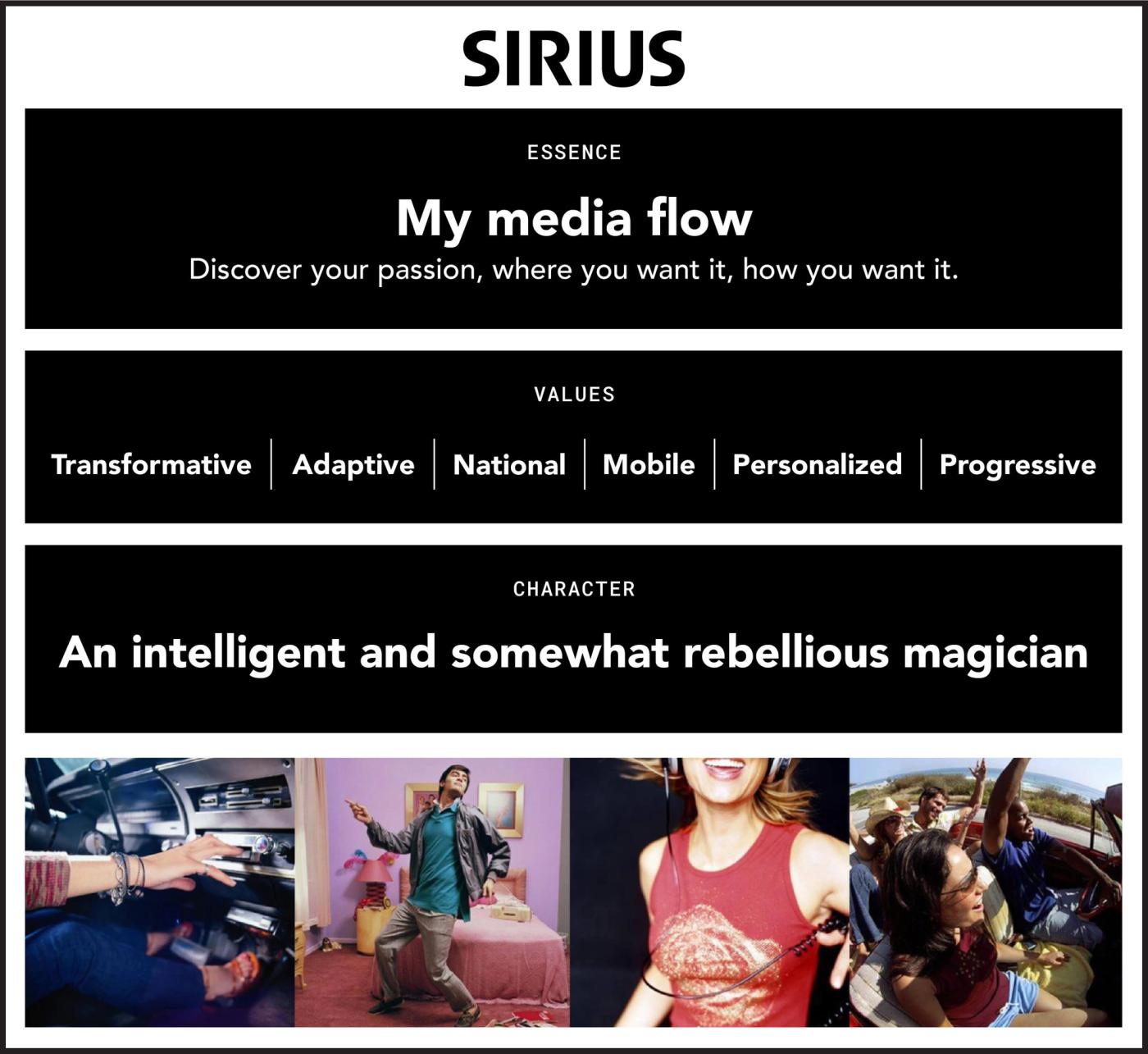
Sirius was inherently progressive. Tuned into the present and moving confidently ahead of it. It anticipated emerging trends, elevated influential DJs, and aligned with cultural moments that mattered. Rather than keeping pace, Sirius set it—redefining what listening could be.
To capture this essence, we coined a brand frame: Media Flow—your media, hassle-free. Always in tune. Transformative. Adaptive. Ubiquitous. Live.
We also defined Sirius's brand character as “an intelligent and somewhat rebellious magician”—a brand that constantly surprised, consistently stayed ahead, and continuously elevated the media experience.
3. Knowledge to Insights

Innovations that People Crave
Sirius wasn’t just improving commercial radio—it was reinventing it. Where traditional radio meant passive listening, Sirius offered something transformative: active discovery, seamless portability, and a personal connection to content that moved with you.
With a clear understanding of what listeners truly craved, we developed a strong generative and evaluative framework—a strategic compass that guided everything from product line strategy and development priorities to rollout timing and roadmap design.
4. Insight to Value-Based Ideas
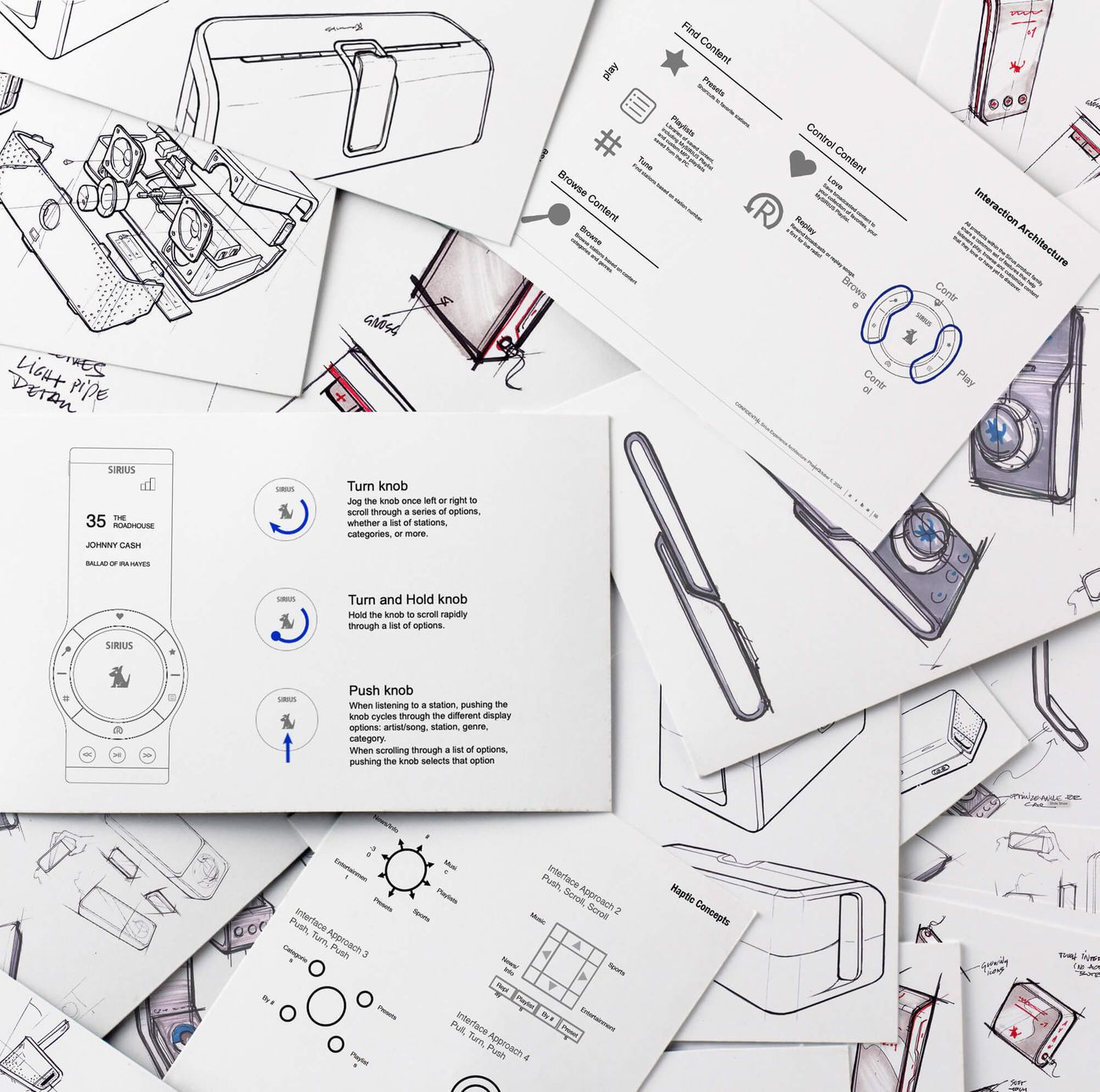
From Insight to Experience to Impact.
In ideation, our mission wasn’t to add more but to reduce complexity. It was to make things simpler, smarter, and more intuitive. Every decision flowed through one core filter:
Does this enhance emotional value without increasing cognitive load?
This lens shaped everything—from product interfaces to physical form factors, from packaging to recyclability. We weren’t just designing for interaction; we were designing for the entire lifecycle.
To bring it all together, we developed a cohesive design language that unified every touchpoint—from hardware to UI/UX to interaction design. The result is a seamless, brand-authentic experience that feels as thoughtful as it is powerful.
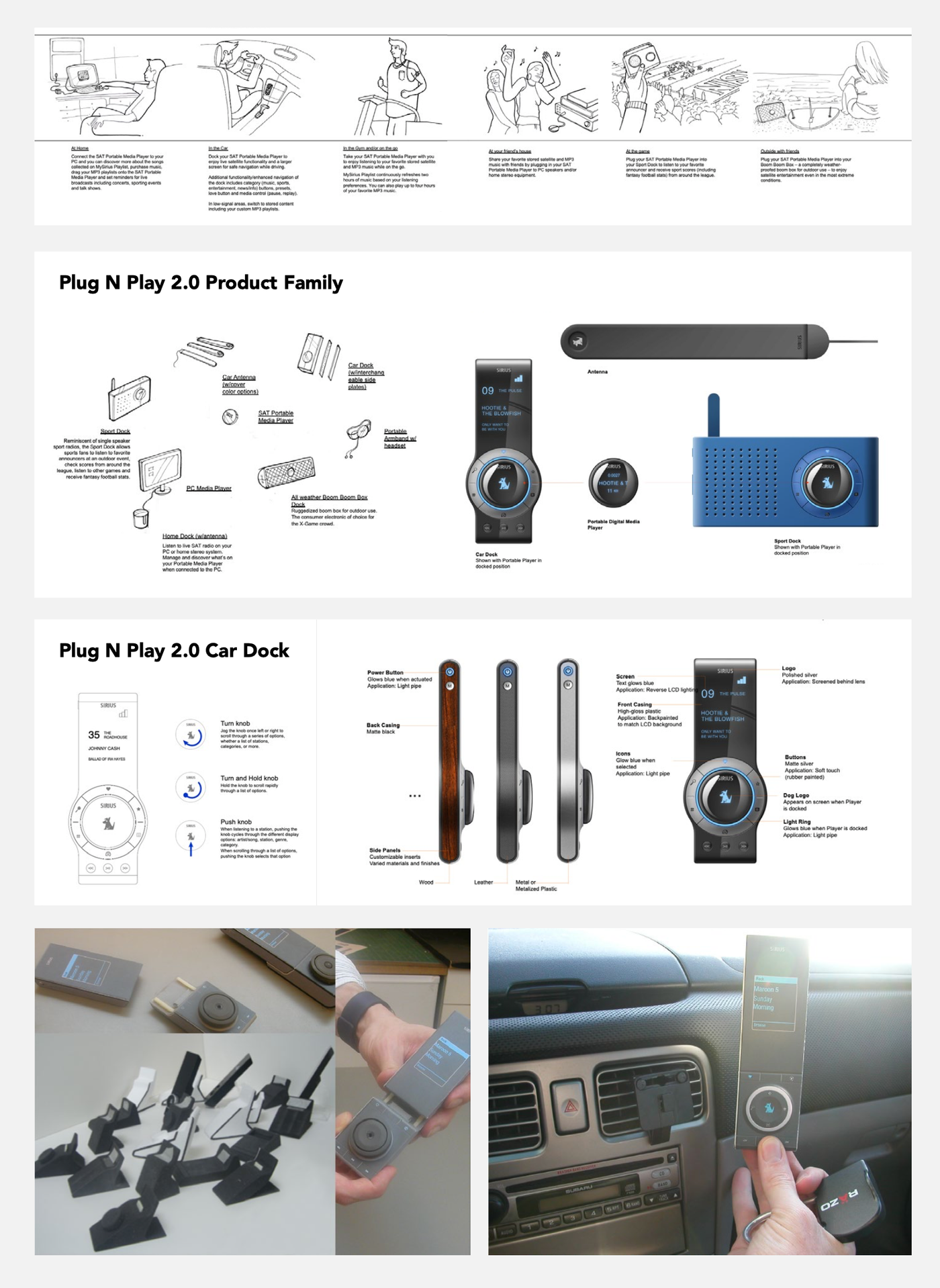
Designed for Freedom, Built for Flow
Plug N Play 2.0 was a breakthrough platform that reimagined how satellite radio could enhance modern life. Purpose-built to meet the needs of three of our key listener profiles—the Fanatic, the Networker, and the Tuner—it offered a deeply personal experience that flowed effortlessly with users throughout their day.
At its core was a bold, human-centered idea: a portable media player with environment-specific docks, enabling effortless transitions from car to home and from office to on-the-go, without ever losing connection or context.
Instead of layering on features, we focused on reducing friction. The design emphasized simplicity, relatability, and emotional resonance. To bridge the gap between cutting-edge technology and user comfort, we drew inspiration from the familiar form of the transistor radio. The inclusion of a physical dial wasn’t just nostalgic—it created a tactile, intuitive interface that demystified the tech and made it feel instantly approachable.
That same intentionality shaped every detail—from interaction design and materials to packaging and the product's end-of-life. We designed not only for utility, but for continuity, delight, and sustainability.
Redefining an Industry. Rocketing Growth.
Ziba’s innovation strategy delivered far more than a better product—it transformed Sirius and brought its brand promise to life. It redefined the industry and sparked a shift in the entire category. By turning cold, complex technology into a profoundly human experience, we helped make Sirius something people embraced—and fell in love with.
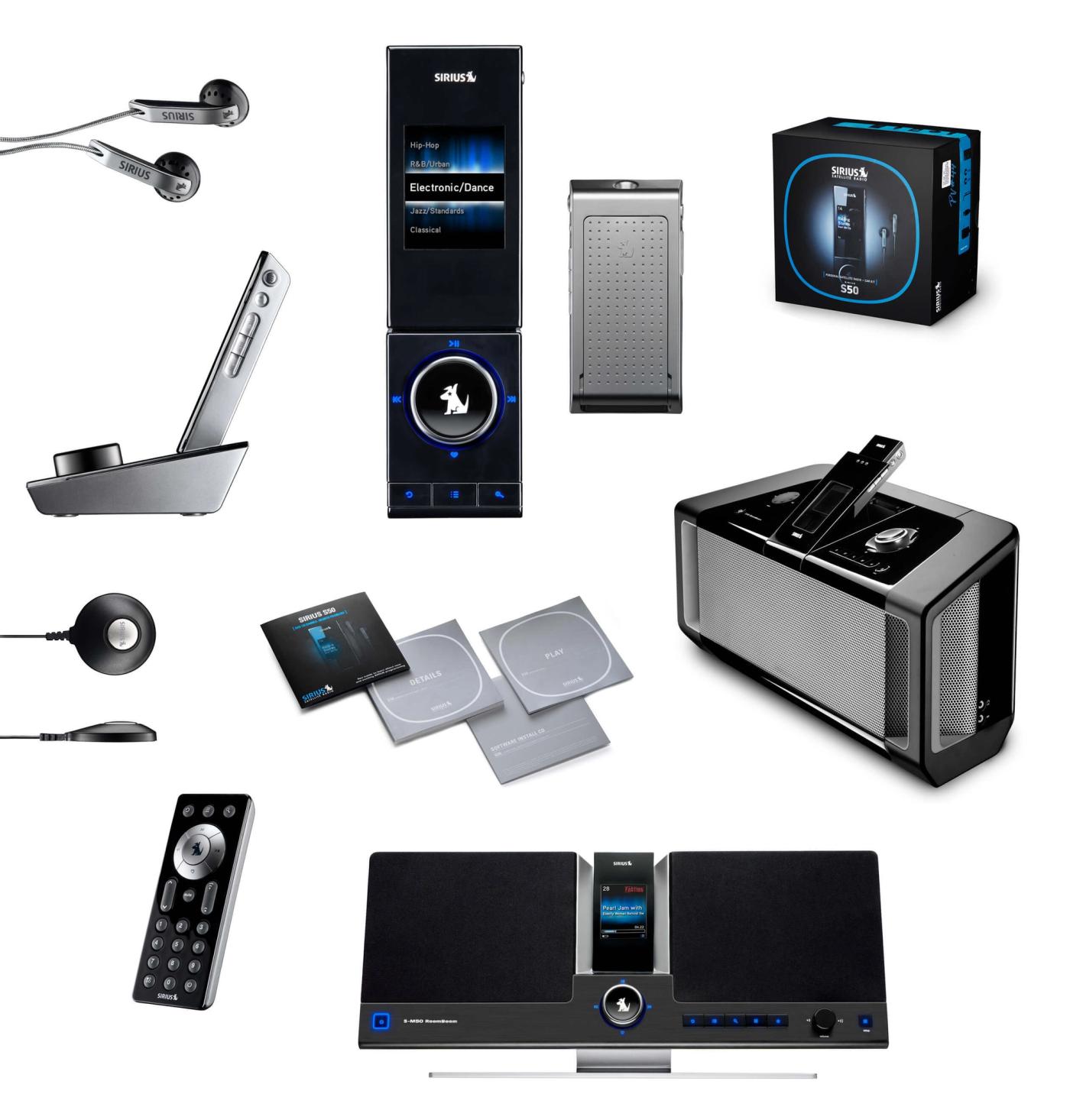
Breakthrough #1: The Sirius S50
- Market Debut: Instant hit—featured in Best Buy’s Top Ten Holiday List.
- Demand Surge: Sold out in six minutes via Yahoo! promotion; generated $3M+ in earned media.
- Media Buzz: Covered by The New York Times, Forbes, Business Week, Rolling Stone, People, Popular Science, Men’s Health and more.
- Cultural Moment: Endorsed by Howard Stern— Sirius’s most visible advocate.
- Critical Praise: Forbes declared, “Give the iPod away and get Sirius’s slick new S50.”

Breakthrough #2: The Stiletto
- Holiday Blockbuster: 68,000+ units sold in just three months—performance redefined.
- Revenue Growth: $20M in retail sales plus $10M+ in recurring annual subscriptions.
- Category Disruptor: Outsold XM’s devices by a factor of 4 to 1 during the season.
- Critics’ Favorite: CNET gave it an “Excellent” 8.0—describing it as “thoughtfully designed to maximize user enjoyment.”
Are you ready to explore how Visioneering can drive your next breakthrough—or empower your team?
Contact us to start the conversation.

